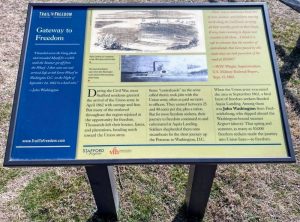Markers
Gateway to Freedom Marker
Marker inscription:
“I bounded across the Gang plank and concealed Myself for a while until the Steamer got off from the Wharf. I then came out and arrived Safe at 6th Street Wharf in Washington D.C. on the Night of September 1st, 1862 in a hard rain.”
—John Washington During the Civil War, most white Stafford residents greeted the arrival of the Union army in April 1862 with outrage and fear. But many slaves throughout the region rejoiced at the opportunity for freedom. Thousands left their houses, farms, and plantation, heading north toward the Union army.Some “contrabands” (as the army called them), took jobs with the Union army, often as paid servants to officers. They earned between 25 and 40 cents per day, plus a ration. But for most former slaves, their journey to freedom continued to and culminated a Aquia Landing. Soldiers shepherded them onto steamboats for the short journey up the Potomac to Washington, D.C.
When the Union army evacuated the area in September 1862, a final burst of freedom-seekers flooded Aquia Landing. Among them was Fredericksburg slave John Washington, who slipped aboard the Washington-bound steamer Keyport (above). That spring and summer, as many as 10,000 slaves made the journey into Union lines—to freedom.
…There was a continuous black line of men, women, and children moving north along the [rail]road, carrying all their worldly goods on their heads. Every train running to Aquia was crowded with them…I think it is safe to estimate that the number of contrabands that have passed by this route since we took possession of the road at 10,000.”
—W.W. Wright, Superintendent, U.S. Military Railroad Report, Sept. 17, 1862.

